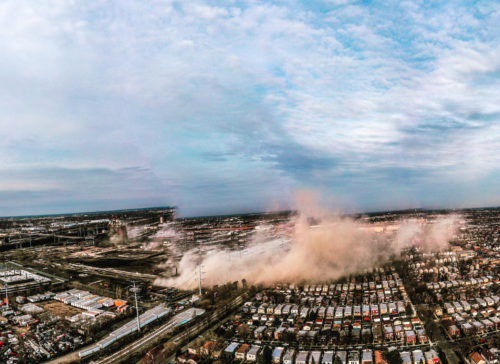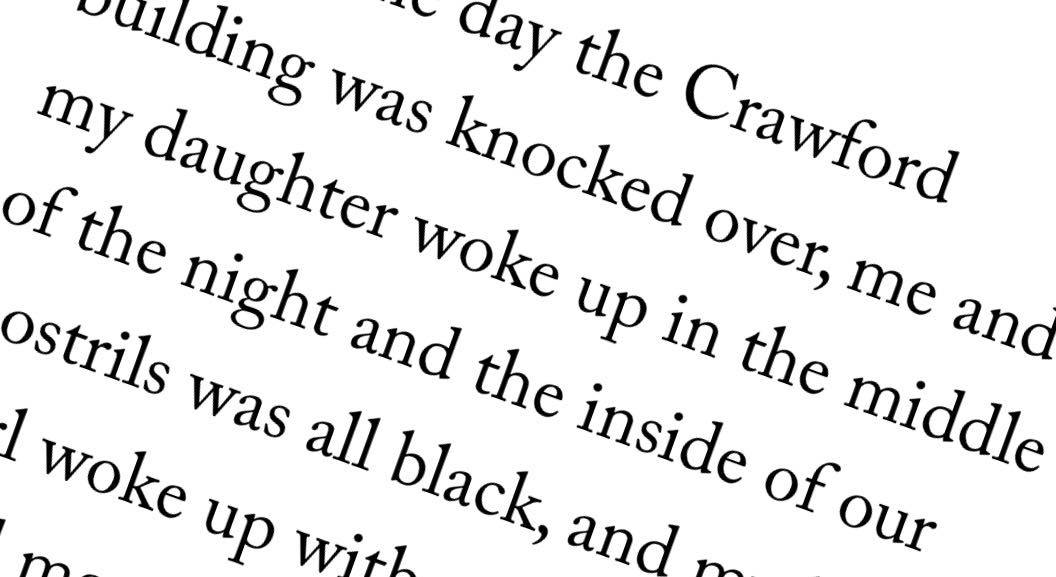Little Village residents are sharing what they experienced when the April 11 demolition of a smokestack at the former Crawford coal plant at 35th and Pulaski released a thick cloud of dust—which the city and U.S. EPA concluded caused “no apparent health risks”—over their neighborhood. This was a South Side Weekly collaboration with the “La Villita, Chicago” community Facebook page that the author comanages. Full names are not provided to protect people’s privacy, and comments in Spanish were translated to English. If you or someone you know would like to share your experience, please leave a message at (773) 295-0206.
Reflections about the implosion
Jose: They weren’t dumb. They knocked it down on a day when the wind was blowing from south to north? I mean, the dust falls here in a Latino neighborhood and North Lawndale, a Black neighborhood. Why didn’t they knock it down when the wind blew from north to south? (4/11/20)
Daniel: The dust came all the way here. I was outside in my alley when I heard the loud bang and I looked south when the smokestack was coming down, and right after that I could see shiny particles flying in the air, good thing I had my mask on. (4/12/20)
Brenda: The amount of notice was inadequate. The alderman’s website didn’t send out notice until the day before at 2pm and he decided to address this issue today at 5pm after the demolition has occurred and the dust is settling in the lungs of our community. Normally water is used to contain the dust during projects like these and this was not the case. It was also completely irresponsible to carry out this work amid a global pandemic affecting the respiratory system. The lungs of our people have been under constant attack. First when the coal plant was functioning, then by the rise of industry pollution, followed by the COVID virus, and now they add this attack on the health of our community. (4/11/20)
Ruby: Since it’s an old building that possibly contains asbestos, the dust had to be contained by the firefighters so that it would not spread to the community, especially since Little Village is one of the areas with the most cases of asthma and this can affect the people who already have respiratory problems and will not be able to be treated adequately in the hospital because their first concern is patients with symptoms of COVID-19. So people are concerned and angry because if it were an Anglo community they would have seen dozens of firefighters ensuring that dust did not spread. But as always they screw us over, and we do not come together to demand better for our community. (4/11/20)
Jefe: Why did the multi-million-dollar company not use a proper dust suppression system? Especially during a respiratory pandemic, that’s bullshit! That company needs to be sued BIG TIME. This wouldn’t have been allowed on the North Side or any other non-minority neighborhood. We need to file a class action lawsuit. (4/11/20)
Ramon: After what they did—this is our community—why should we let them build something that isn’t going to benefit us? Let’s ask for a park or a building that’s going to benefit us on that property. (4/13/20)

One dead after the dust settled
Efrain: Fernando Cantú passed away early Easter Sunday morning at 3am, shortly after the demolition of the Crawford power plant smokestack, which we believe could be a primary cause of his passing. He came out to his garden on Saturday afternoon, and by 3am on Sunday he was dead. He was seventy-eight years old and suffered from asthma and COPD but he lived a normal life and his death was very abrupt. (4/14/20)
Elisa: It makes me very sad to know that he is no longer with us, he was a very kind man and he got along with everyone. He was always greeting people that were passing by. My dad liked to talk to him. Since he lived there for many years, I imagine that he was very loved by all the neighbors. May he rest in peace and my deepest condolences to the family. (4/14/20)
Howard: Mr. Cantú loved to go outside in his beautiful backyard and/or walk early every morning, including the morning of the deadly dust storm. He was a wonderful person whom I knew as his physician for many years and as his neighbor. May he rest in peace alongside our brother Reynaldo Grimaldo, another La Villita neighbor and demolition worker, who fell to his death at the Hilco site. (4/12/20)
Pain and breathing issues
Leticia: The day of the explosion I went out to throw out the trash and it smelled like a lot of dust and like something was burning. Since then I have a dry throat and my eyes are burning and crying a lot. And every time I go out to throw out the garbage or sweep the yard, the same thing happens and even after I enter the house, my throat itches and eyes water. I don’t know if someone could help me or where I can go for help. (4/24/20)
Marta: The day the Crawford building was knocked over, me and my daughter woke up in the middle of the night and the inside of our nostrils was all black, and my little girl woke up with a headache. She told me that her head hurt a lot and to date she tells me that it hurts, though not as bad. (4/24/20)
Robert: A little while after the demolition, my father began to experience coughing attacks. We’ve gone to the doctor and he’s been told he has bronchitis. He’s missed several days of work because of this and we’re still hoping his coughing attacks will soon subside. (4/24/20)
Dalia: Some weeks ago I started to feel that my chest hurt. I suffer from asthma and use an inhaler. I feel like I am constantly short of breath and that hasn’t happened to me in years. It was bad luck, that day I didn’t know about the demolition and I went shopping close by and without knowing I exposed myself to it. And since the day of the coal plant demolition, I started to feel chest pain and now I get more frequent asthma attacks. That’s why on Monday I have an appointment with the doctor so he can do a check-up and prescribe me an inhaler. (4/25/20)
Alfredo: What happened is that my baby got sick after that day. He had asthma, his nose was stuffed, and he got worse after that day because of what happened. In other words, I think that what they did is not right, because we did not know that they were going to do [the demolition], nobody warned us or anything. (4/25/20)
Jessica: I have family members who are dying in the hospital because they cannot breathe and I live very close to where they did the demolition and right now we all have the virus. (4/27/20)
Claudia: I get a lot of headaches and one eye hurts. That day when we felt the blow of the demolition throughout the house, I got a headache and I couldn’t breathe. I do not suffer from asthma, I do not suffer from [any] of those types of diseases. It was so difficult for me to breathe that I had to go find a relative so she could lend me her humidifier. At night I began to feel that the air was coming in a little cleaner. But since then I’ve had pain and I already finished a bottle of pills. (4/27/20)
Maria: I suffer from asthma and ever since I’ve been feeling sick, so I got more medicine to deal with my allergies and other symptoms. That day, my husband also went to the hospital because he couldn’t breathe, it’s almost as if his throat was congested. He went to the hospital and got the test for coronavirus. He didn’t have it, he was just irritated from the dust. We live by where [the demolition] happened. (4/28/20)
Jacqueline Serrato is the editor in chief of the South Side Weekly. She last wrote about emergency SNAP benefits during COVID-19.

